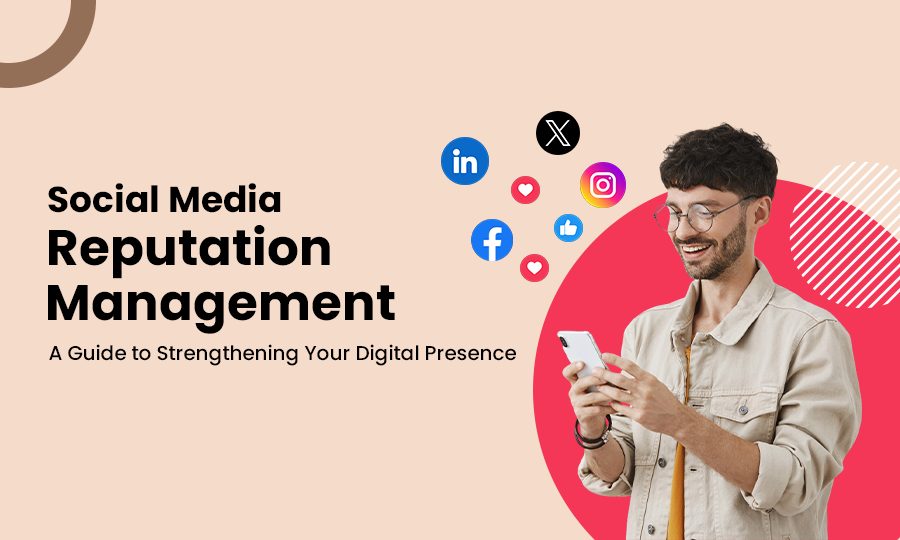In the past few years, social media has taken over the world by keeping businesses connected with the worldwide audience and everything they share online. Apart from what a business shares on social media, how they’re perceived by the social media audience is also crucial. Thus, social media reputation management (SMRM) plays a major role for businesses to showcase their credibility and build customer trust.
According to a Wiser Notify study, 87% of buyers think that social media helps them in making purchase decisions. Those who are interested in you as a person or your business are more likely to follow you on social media.
Thus, taking control of your social media reputation has become extremely necessary. It is more than just managing the social media reviews and preventing crises.
In this blog, you’ll learn the role of social media in your brand reputation and all the tips for managing social media reputation of your brand. Before we dive into details, let’s have a clear understanding of the concept first.
What Is Social Media Reputation Management?
It refers to a proactive strategy of monitoring, managing, and influencing how your business appears across social media platforms and how the social media audience perceives it. It requires you to engage more with your audience to shape a positive reputation on social media.
Today, everyone is connected through social media platforms such as Facebook, Instagram, X (previously known as Twitter), and LinkedIn. So, an impressive social media presence is vital for your business.
And that’s where social media online reputation management comes into play.
It offers you an opportunity to express what your business truly is to the world. From monitoring social media brand mentions to managing reviews and comments, it involves numerous other crucial practices through your brand’s social media handles.
Seems manageable, right? But it requires –
- Sharp analytical skills
- Timely observation
- Knowledge of effective social media usage
- Effective strategies to implement
It’s not just a practice to manage your online reputation through social channels, but rather a vigilant activity to uphold your brand’s identity in your target market.
What if It Gets Unchecked?
If you don’t prioritize managing your brand’s social media reputation, it can negatively impact your customer trust and even your business revenue.
Did you know that 95% of adults (18-34 years) follow brands on social media?
It’s more likely that most of your potential and existing customers follow your brand on social media. If you lack a positive presence across social media platforms and a good number of loyal followers, you may be losing thousands of meaningful business opportunities.
If this is left unchecked, your brand reputation on social media will run its own course depending on the varied experiences of those who’ve interacted with your brand. And it works until people have negative experiences with your brand and share their reviews on your social media profiles!
- Negative customer comments and reviews can damage your brand image.
- Misinformation about your brand can be spread like wildfire on social media.
- You may not generate qualified leads from social media.
- You may experience a significant loss in new customer acquisition and struggle to drive sales.
- A negative brand image may circulate on social media and other digital platforms.
To prevent these damages, you need to implement certain effective SMRM strategies or partner with a renowned online reputation management agency. It’ll be a sound strategic decision to grow your brand on social media and take the next step towards success.
What is the Role of Social Media in Managing Brand Reputation?
Consumer perception can make or break your brand reputation. No matter whether you’re an entrepreneur, a professional, or own a brand, having a social media account is not enough for you!
With the ever-increasing use of social media, what you post and say online has a direct impact on your online reputation. It can either cause significant reputational damage or open doors to thousands of exciting opportunities.
Fact Check: 77% of consumers prefer purchasing products or services from brands they follow on social media. So your goal is not only to influence your potential customers to follow your business on social media but also to purchase from it.
Thus, you need to excel in social media reputation management to positively influence the purchase decisions of your potential customers and every social media user.
Still confused? Let’s understand it in more detail.
Social media offers you a platform where you can –
- Directly communicate with your potential and existing customers
- Convey your brand messages
- Facilitate real-time feedback from your social media followers
- Monitor your brand’s online presence
- Address negative feedback promptly
- Influence public perception through strategic engagement
These factors are the key components in building and maintaining a positive online reputation. It helps you build public trust, loyalty, and positive brand associations. You can actively participate in meaningful online conversations with your social media followers and effectively respond to their queries regarding your business offerings.
As a business owner, you can showcase your commitment to customer satisfaction and enhance your overall brand reputation.
Want to build stronger and more meaningful relationships with your customers? This is also possible if you monitor and manage your social media handles and use them to improve your brand reputation.
How to Manage the Social Media Reputation of Your Brand?
Social media is not just a tool for engaging with your customers, but rather it’s a great platform for managing and improving your brand reputation. But this is not as simple as it seems!
The only condition to leverage the millions of benefits social media offers for your brand reputation is to use every social media platform effectively. The right application matters – that’s where social media online reputation management comes in.
It’s time to reveal the secret of impactful SMRM strategies for your brand. Let’s know how you can effectively manage your brand reputation across popular social media platforms.
Step 1: Determine Where Your Social Media Reputation Currently Stands
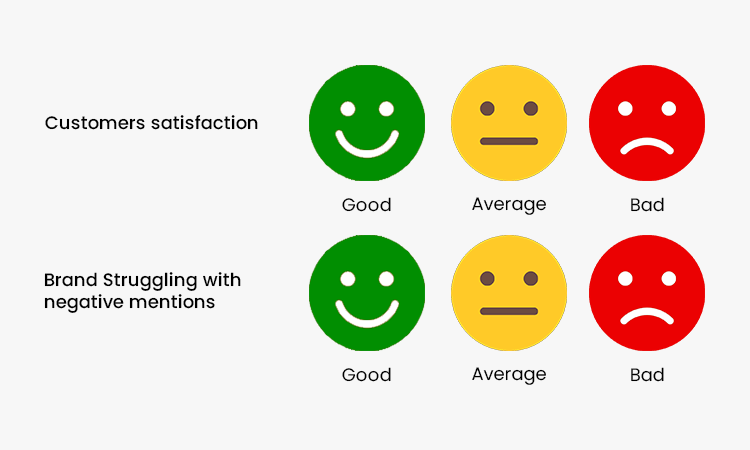
Social media is a delicate digital asset of every brand.
Why? It can make or break your business reputation online, influencing how the social media users (including your customers, consumers, and followers) feel about your brand.
First things first: You need to figure out where your brand reputation stands right now. People don’t always need to have the same perception about your brand. Thus, it’s crucial to identify how your brand is being perceived by the social media audience currently.
Questions to cover:
Try to find out the answers to the following questions.
- Are your existing customers satisfied with your business offerings?
- Is your brand struggling with social media criticism, such as negative mentions, comments, and reviews?
- Is your brand facing a situation somewhere in between the above two?
Wondering where you can collect these social listening data and clues to find out the answers to these questions? Here we’ve mentioned certain digital data sources to help you seek the answers.
- Social media posts
- Social media mentions (positive, negative, or neutral)
- Online reviews and star ratings from third-party sites
- Mentions from industry blogs and online publications
- Real customer feedback through emails, online surveys, and contact forms
You need to track the above-mentioned sources to gather the required data to assess your brand reputation on social media. A bonus benefit! This process can help you identify the ratio of positive and negative comments.
You can analyze customer sentiment – if the majority of responses are positive, that’s extremely good for your brand! It means your social media brand reputation is strong and positive. If not, then you’ve got to do some hard work!
Here’s a quick step-by-step guide to identify where your brand reputation stands.
Step 1: The first step is to search your brand name on search engines like Google and Yahoo. Additionally, you can search your business name on social media platforms like Facebook, Instagram, LinkedIn, and the like.
Step 2: Track the hashtags, name mentions, reviews, and comments your brand’s social media handles have received so far. Try the ratio measuring method – are the majority of the reviews positive or negative? To simplify this, you can hire professional online review management services from renowned online reputation management agencies.
Step 3: You can use free and paid tools like Google Alerts, Mention, and Brandwatch to monitor your social media mentions and reviews. We’ll talk about the usefulness of these social media tools later in this blog.
Step 4: You must identify frequent complaints, positive or negative sentiments, and recurring praise about your offerings through social media comments and reviews.
Step 2: Define Your Brand’s Online Voice and Values
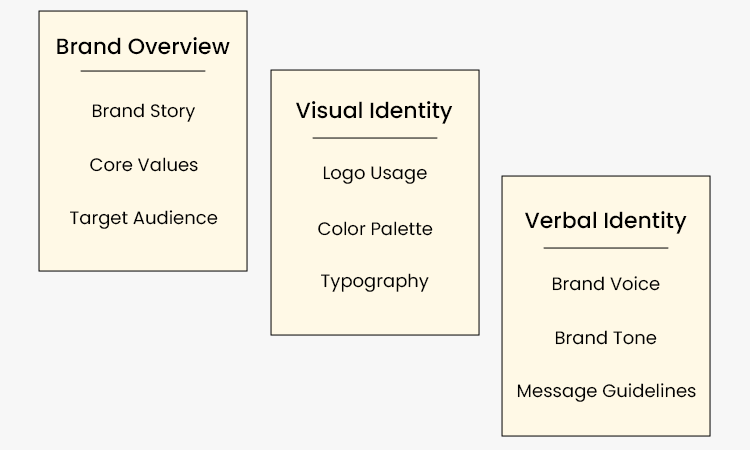
You must set and define a set of rules and standards for your brand to ensure how it should be represented across channels like social media. To ensure how your brand communicates on social media, you must ensure consistency in your –
- Brand messaging
- Appearance
- Overall online identity
How to Define Your Brand’s Online Voice?
Here are some easy ways to define your business’s online voice for social media reputation management.
- Define your brand characteristics – Determine whether your business’s key characteristics are ‘friendly’, ‘professional’, ‘casual’, or ‘humorous’.
- Break down the traits – You can break down these traits into specific tones. For example, if your brand’s key characteristic is friendly, you can express your brand voice in casual language and emojis. On the other hand, a professional brand voice can be conveyed via formal language.
- Create guidelines – We suggest you create guidelines for languages, imagery, and engagement tactics you’ll use to define your brand voice – which language should be used? Which tone shouldn’t be? How should you respond to different types of social media comments? Which emojis are formal?
- Personalize your brand voice – Adjust your brand voice based on the social media platform and the type of content you post. A witty update is ideal for Twitter, while a formal post is better for posting on LinkedIn.
- Share with your team – It’s important to document your brand’s voice guidelines and share them with your team. So that your team has a clear idea of it.
How to Define Your Brand Values?
Follow these tricks to define your brand values to manage your reputation across social media platforms.
- Identify core values – Have a clear idea of the principles that guide your business – sustainability, customer-centric, or innovation.
- Align your social media content – You need to ensure that you share social media content that appropriately reflects these principles or values. Or else, it can confuse your potential customers or followers.
- Maintain brand authenticity – You can share how your brand was started, what mistakes you made initially, the lessons you’ve learnt, and demonstrate your brand values in action. These are crucial to maintain the authenticity and transparency. Transparent communication of brand values builds trust and recognition among your social media audience.
- Monitor and respond – Always pay attention to how your target audience perceives your brand on social media. Based on this, you can tailor your response to feedback, address their concerns, and promote positive social media interactions.
- Highlight your brand’s uniqueness – You need to promote what factors set your brand apart from its competitors
Step 3: Set Up or Optimize Your Social Media Profiles
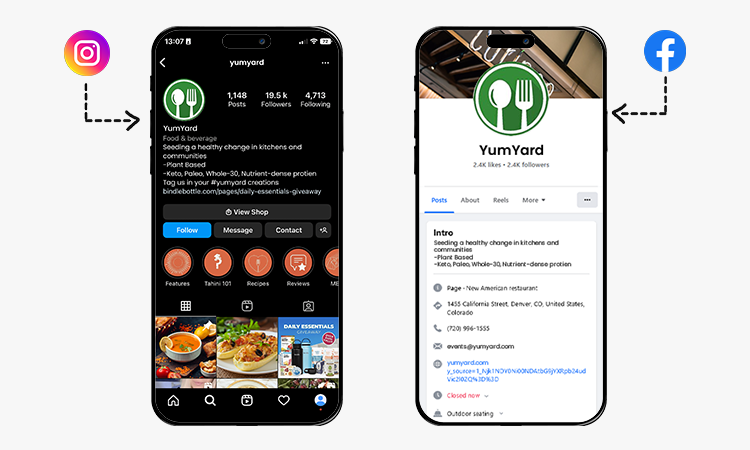
Every business, no matter a small start-up or a large enterprise, should have an effectively optimized social media profile. According to a 2024 study by Statista, more than 83% of marketers believe that the right utilization of social media increases business exposure.
To ensure a consistent and professional online presence, every brand should prioritize setting up profiles on popular social media platforms like Facebook, Instagram, and LinkedIn. This involves some crucial tasks, including the usage of the logo, username, and bios.
- Logo – You must use the same brand logo across all the social media platforms. It is crucial for maintaining your brand recognition.
- Username – We suggest you choose a consistent and easy-to-remember username for your social media handles. The username must reflect your brand value and approach towards customer service.
Note: Your selected username can be unavailable as other brands may have the same username. For such cases, you should try to find a close abbreviation of your chosen username.
- Bio – Your social media bio must be concise and clearly convey what your brand does. It should also reflect your unique value proposition and other key information. You can even add links to your official website or ‘contact us’ page, along with the details of your industry, target audience, and a call to action. Keyword-optimized bios can help your potential customers easily find your social media profiles.
Add the following aspects to your bios.
- What does your brand do?
- What problems does it solve?
- What makes your brand stand out in the market?
- What values does it offer to customers?
Sample Social Media Bios for Businesses
Here are some social media bio references for your brand. However, feel free to make necessary changes and personalize it according to your requirements.
For a restaurant –
“(Your restaurant name) – Where we serve delicious Italian meals and good vibes! Enjoy live music and make great memories. Visit us today!”
For a doctor –
“Board-certified pediatrician with 10+ years of experience | Dedicated to providing comprehensive and compassionate care for children of all ages | XYZ Pediatric Clinic | www.xyzpediatricclinic.in”
For a lawyer –
“Experienced attorney specializing in real estate law. Helping clients navigate complex legal challenges with practical solutions. Connect and discuss your legal needs.”
Step 4: Follow a Proactive Approach While Responding to Mentions, Comments, and Reviews
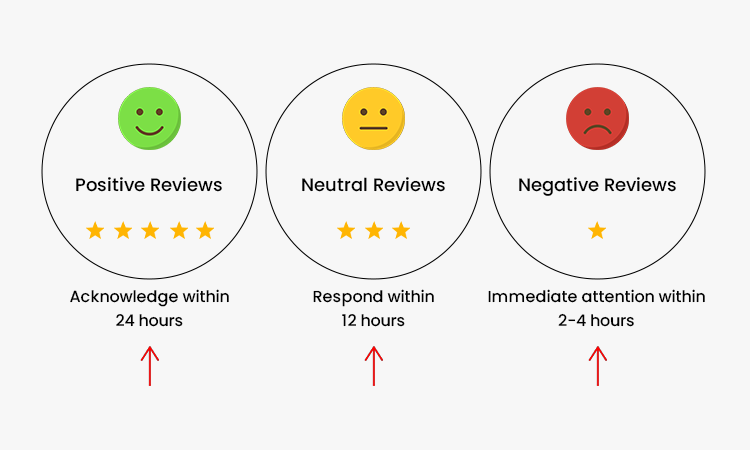
It’s now time to learn the secret of proactively responding to your social media audience. How you respond to comments, reviews, and mentions on social media plays a huge role in social media reputation management.
This is quite complex until you know how to do it!
It’s not just about responding; it’s about responding at the right time. This means you need to set up real-time notifications for the following things –
- Comments, @mentions, and tags of your business (e.g., @XYZclinic or @XYZbakeryshop)
- Brand-specific or product/service-specific hashtags (e.g., #XYZlawfirm or #XYZdentalcareunit)
- Branded keywords (e.g., for a corporate firm named XYZ Technologies, the keywords can be XYZ, XYZ customer service, XYZ office space near me)
Setting up notifications for the above-mentioned things can speed up your social media response time. It can also help you promptly acknowledge positive comments and mentions, while professionally reacting to negative ones and offering a solution.
Did you know that 40% of customers expect a brand response to their social media comments/mentions/posts within the first hour, and 79% of them expect a response in the first 24 hours? Thus, responding within a specific time frame is crucial to maintain customer trust.
To set up the notifications, you need to use a social listening tool like Mention or Brandwatch. Though Google Alerts is a free tool, it lacks social media management capabilities and provides notifications for your brand mentions across the web.
How to Set Up Notifications for Your Brand Name?
Let’s have a look at the following steps.
- Make a list of keywords, phrases, brand names, hashtags, and social media handles for which you want to set up alerts.
- You need to use Boolean operators like AND, OR, and NOT to refine your search and exclude irrelevant mentions.
- Set up how frequently you want to receive the alerts – real-time/daily/weekly.
- Additionally, you need to set up which things you want to receive alerts for – social media DMs, reviews, comments, hashtags, and mentions.
- After that, you need to choose the way you want to receive the notifications, such as through email, SMS, or push notifications.
- If the tool offers sentiment analysis features, you can assess the tone of the mentions – are they positive/negative/neutral?
- You can also include or exclude specific sources, which is called Whitelisting and Backlisting.
For the Mention tool, you can follow these steps –
Visit the Mention tool > click on the ‘Add a new alert’ button at the top left sidebar > select ‘Basic Alert’ or ‘Standard Alert’ > Enter the keyword > enter the Boolean operator > include hashtags > specify terms you want to backlist > choose language > select the social media platform > choose alert frequency > select the alert receiving method > save it
Step 5: Respond to Feedback – Fast and Professionally
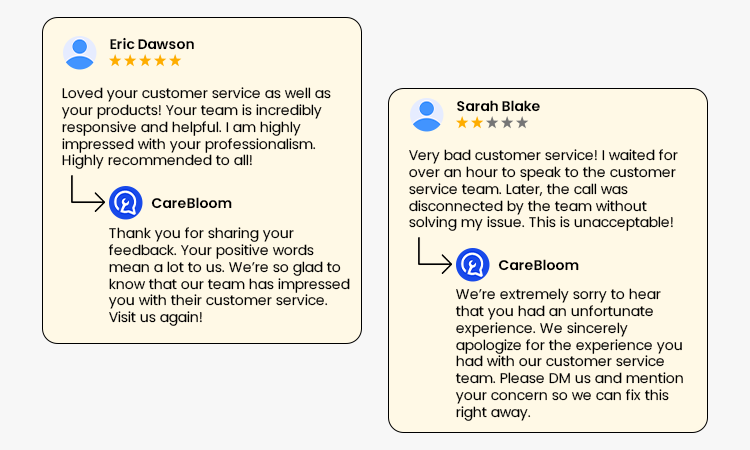
It may sound unreal, but a positive and proactive response even to the negative comments and reviews can help you go a long way. An effective response to social media reviews is a fundamental aspect of social media brand reputation management.
Every feedback, positive or negative, offers you an opportunity to build your social media online reputation. It shows your audience that your brand’s social media handles are not just a faceless entity but a customer-focused organization.
Here are some quick and easy tips to professionally respond to social media reviews.
- Personalize your response – You must tailor your response and avoid a generic one when you reply to social media feedback. You can address the reviewers by their name or talk about their mentioned concern in the response. Such tailored responses feel more genuine.
- Add an acknowledgment – Never forget to add an acknowledgment or appreciation later in your response – write ‘Thanks for sharing your feedback’.
- Solve issues offline – It’s good to take things outside social media and handle them offline. It’ll help you avoid unnecessary online conflicts.
- Respond promptly – It’s crucial to always aim for a quick response. It shows how much you value your customers’ opinions and that you’re actively engaged with your audience.
- Maintain a professional tone – Always maintain a professional and courteous tone while responding to the feedback, even if the feedback contains harsh words. For the positive reviews, you must appreciate the reviewer for taking the time to share their positive feedback.
How to Respond to Positive Social Media Feedback?
Are you planning to say a little ‘thank you’?
Let us tell you that a simple ‘thank you’ may not work every time. You may need to write a complete response to the positive reviews.
- Never forget to properly respond to the positive customer feedback you receive through social media.
- Highlight the factors for which you’ve received the appreciation.
- You must appreciate the reviewers for their support and promote their positive reviews on your social media business account and website.
Example of a Sample Response to Positive Feedback
Feedback: ‘Loved your customer service as well as your products! Your team is incredibly responsive and helpful. I am highly impressed with your professionalism. Highly recommended to all!’
Response: ‘Thank you for sharing your feedback. Your positive words mean a lot to us. We’re so glad to know that our team has impressed you with their customer service. Visit us again!’
How to Respond to Negative Social Media Feedback?
Got negative reviews? No need to worry, as they’re just opportunities to identify your flaws and improve your customer service.
We know that it’s difficult to stay calm and composed when someone pinpoints your drawbacks. But by doing the same, you can turn your negative reviews into an opportunity to gain back your customers’ loyalty.
- Apologize sincerely if necessary for the inconvenience the reviewer faced, and try to take the conversation offline. This is the best way to avoid online conflicts with your customers, as your response is visible to all, and you cannot risk your online reputation.
- Impactful responses to negative feedback are crucial for social media reputation management. When someone complains about your business on social media, you must address their concerns and suggest resolutions to rectify the situation.
- Acknowledge the issue and take responsibility for the negative experience the reviewer had. Being defensive may portray your brand image negatively.
- If it requires detailed discussions, you can request the person to visit your office for a personal conversation or contact them via direct call or email.
Example of a Sample Response to Negative Feedback
Feedback: ‘Very bad customer service! I waited for over an hour to speak to the customer service team. Later, the call was disconnected by the team without solving my issue. This is unacceptable!’
Response: ‘We’re extremely sorry to hear that you had an unfortunate experience. We sincerely apologize for the experience you had with our customer service team. Please DM us and mention your concern so we can fix this right away.”
Step 6: Create and Post Quality Content Consistently
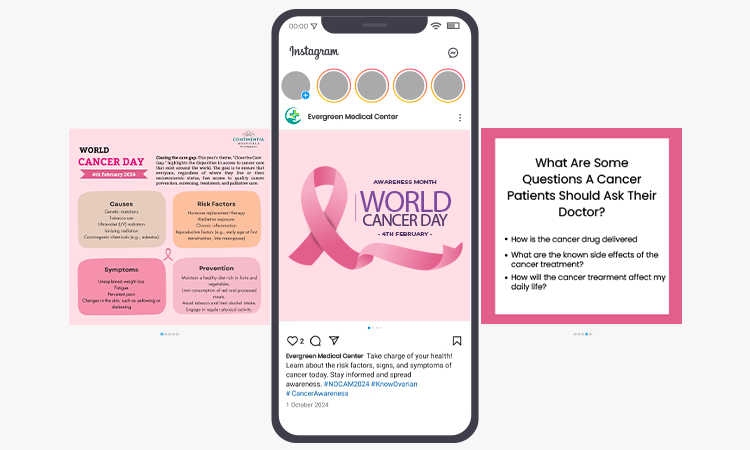
Your content strategy forms the foundation of your brand authority and online reputation. The content you’ll post on social media is crucial to your brand promotion as well. It adds genuine value to your brand’s social media reputation and makes a massive difference in building customer trust.
How Does Social Media Content Work for Your Brand Reputation?
It enhances your brand visibility on social media, providing actionable insights about your offerings and brand approach. When you post high-quality social media content about your business, it humanizes your entire brand. It will help you create a stronger emotional connection with your social media audience.
Types of Content You Can Share on Your Social Media Account
The following are some major content types that you can consider posting on your social media to improve your brand reputation.
- Behind-the-Scenes Content
- You must showcase the human side of your business and share glimpses into your business culture, team, and work environment.
- You must maintain transparency to build customer trust through the behind-the-scenes glimpses.
- You can share videos of company events, employee spotlights, and the procedure of product development.
- Customer Testimonials
- You can promote the positive reviews of your satisfied customers.
- Request your satisfied customers to send you their video where they share the experience they had with your business. You can post these videos on your social media handles to build your potential customers’ trust.
- You can repost and highlight your customer content and testimonials to provide social proof.
- Educational Content
- You can share valuable information through social media posts about your industry or niche.
- Through the educational content, you must position your brand as a thought leader and valuable resource for your customers.
- You can share how-to guides, easy tips and tricks, industry news, and articles as well.
- Share high-quality images and videos to educate your customers regarding various topics related to your business. A SproutSocial study has claimed that 78% of people prefer to learn about a new product through short video content.
- You can use Canva to create infographics and professional social media posts.
- Interactive Content
- Such content is best for engaging with your social media audience.
- You need to create interactive elements like polls, Q&A sessions, and quizzes.
- Ask for product feedback through polls, test your customers’ knowledge through quizzes, and participate in meaningful discussions through live Q&A sessions.
- Entertaining and Promotional Content
- You must follow the 80:20 ratio for choosing the type of content you want to post on social media. While you should post 80% of entertaining content to ensure better audience engagement, you can share 20% promotional content.
- The entertaining content is fun, engaging, and shareable, so that your social media audience can easily share that content.
- Funny videos, memes, engaging contests, and challenges are some major examples of entertaining content that you can share on your social media handles.
- We suggest that you promote your special offers, discounts, and new product/service launches.
Now that you’ve a clear idea of what type of content you need to share on social media, it’s time to be consistent with posting. You must regularly share high-quality social media posts to keep your audience engaged. To do that, you’ll need a content calendar to create a content creation and posting schedule.
Step 7: Encourage and Showcase Positive Reviews
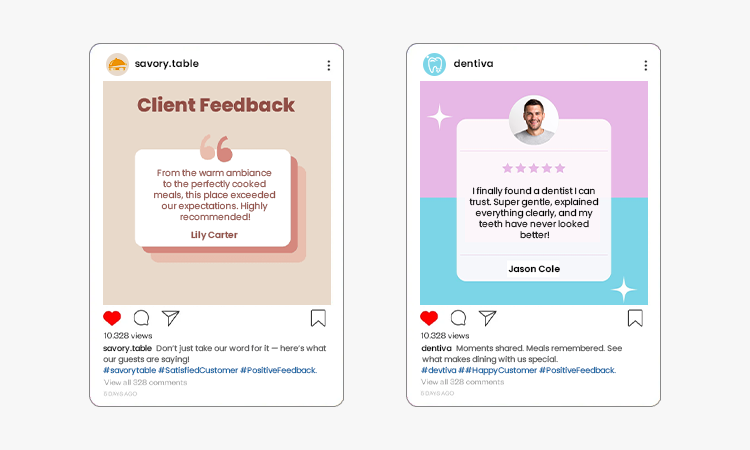
Received some really good reviews for your business offerings and customer services? It’s time to promote those reviews through your social media profiles.
In social media reputation management, the effective promotion of your positive reviews positively impacts your brand image and fosters customer trust. 72% of customers are more likely to trust a business after they read positive reviews and testimonials about it.
Useful Tips to Encourage and Promote Your Positive Reviews
Here are some easy ways to encourage and promote positive reviews on social media.
- Ask a Satisfied Customer -You can ask satisfied customers to share their feedback. You can reach out to them through email after they purchase something from your brand. Additionally, it’s crucial to send follow-up emails to your satisfied customers if they don’t respond to your review request email.
- Make the Review Submission Process Easy -Is your review submission process complex? If yes, your customers may not be interested in sharing their feedback through a complex process. Thus, we advise you to provide clear instructions and links to your preferred review sites. You can implement online review management strategies to effectively manage and promote your positive reviews.
- Incentivize Your Customers -Is it a good idea to offer incentives to your customers for sharing reviews? Yes, it is. You can offer small incentives like discounts and special offers for sharing your positive reviews. But you need to be mindful of the review platform guidelines.
- Promote Positive Reviews-Now it’s time to promote your user-generated content, like positive testimonials and success stories. However, you need to take proper approvals from the reviewer before you publicly post their reviews on your social media handle. Asking for permission is important, especially if the testimonial contains personal information or photos.
Note: Don’t forget to tag the reviewer in your post. - Incorporate Hashtags -Hashtags are the cornerstone to make your social media posts reach a wider audience. So you must incorporate trending and industry-specific hashtags to increase the visibility of your social media post.
Example: You can use hashtags like #CustomerLove, #XYZTechnologies, #HappyCustomer, #SatisfiedCustomer, and #PositiveFeedback.
Step 8: Handle Crises Quickly and Transparently
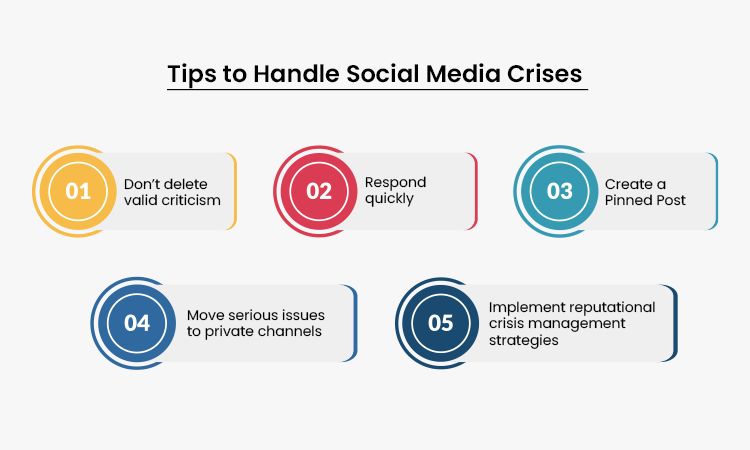
A good social media presence is important for building a positive online reputation. On the other hand, a social media crisis can negatively impact a brand’s online image.
Information spreading like wildfire? We heard – it’s Social Media!
Social media platforms have the power to make even the most unimportant information viral within no time. It implies, a social media crisis can spread quickly and reach a wide audience in a short period.
Social media users instantly share information, which can be detrimental to your brand reputation. A negative social media comment or a bad customer experience shared on popular social media platforms can destroy your business reputation.
Another negative factor?
Imagine someone has tagged your brand in a comment on social media and called it out for its poor-quality products. It is more likely that some other social media users may also have a similar experience with your products. If they also join the claim and share their bad experience, the crisis can further escalate and destroy your brand reputation.
Helpful Tips to Handle Social Media Crises
Social media crises will keep coming your way. What matters is how you handle such a situation! Here we’ll tell how you can effectively handle social media crises to minimize the damage to your social media crises.
- Don’t delete valid criticism – Not all negative social media comments and reviews are spam or invalid. You should not delete or ignore negative comments or reviews that validly criticize your business or its offerings. Always remember, they are the key to identifying your areas for improvement.
- Respond quickly – No matter whether the social media comments or reviews are negative or positive, you must respond to them quickly and address them professionally. It’ll showcase how much you value your customers’ opinions and how you’re committed to delivering the best possible customer service.
- Create a Pinned Post – If the issue mentioned in a social media comment or review, even the topic of the social media troll, is quite significant, you can create a pinned social media post or statement. The issue can be a customer data breach, false claim, delayed shipping of orders, or even a poor quality product/service.
- Move serious issues to private channels – Want to avoid online arguments? It’s best to move the serious conversations with your customers offline. You can request them to contact you through private channels like social media DM or email.
- Implement reputational crisis management strategies – You can follow proven online reputational crisis management strategies to impactfully handle social media crises like trolls, negative mentions, and extreme criticism.
Step 9: Analyze Your Reputation and Engagement Monthly

Conducting performance audits is the first step to identifying how well your social media reputation management strategies are working. It will help you regularly analyze your social media presence and engagement.
Just like a comprehensive examination of your business’s digital footprint!
You can start by reviewing your social media business accounts on Facebook, Twitter, Instagram, LinkedIn, and YouTube. After that, you can check the branding elements like logo, color, theme, tagline, and others.
To do it, you can set up alerts on those social media platforms for your –
- Brand mentions
- Common misspellings
- Product/service names
- Hashtags
- Key executive names
- Competitor mentions
Metrics to Track for Analyzing Your Social Media Reputation
Track the following aspects to analyze your brand’s social media reputation.
- Reputation Score: You can use various reputation monitoring platforms to check the ‘reputation score’ metrics to track the mention reach and sentiment. You can calculate the score from -100 to 100.
- Follower Growth: It will help you identify the number of people who have recently started to follow your business on social media. Additionally, you can also track how many people have unfollowed your social media accounts. With this, it will be easy to understand the social media reach of your business.
- Engagement: How connected your social media audience feels to your business, the products/services you offer, and the content you post – it’s all about your social media engagement! When you see people actively liking, commenting, and sharing your social media posts, it shows a higher engagement rate.
- Sentiment: This metric shows the ratio of positive to negative social media mentions of your business over time. You need to focus on the monthly trends, as daily customer sentiment fluctuation is quite normal! More positive mentions mean you’ve a strong social media reputation, while the majority of negative mentions reflect the sign of having a poor social media image.
- Common Queries or Complaints: Do you receive the same type of queries or complaints through your social media? If yes, it’s time to address them! Too many similar queries or complaints mean you really need to focus on a specific factor regarding your business and improve that aspect at the earliest.
Tools to Use for Tracking the Metrics
You can use the following tools to track the metrics.
- Meta Business Suite – It’s an all-in-one tool by Meta, designed to help businesses manage their social media accounts. Brands can create, schedule, and publish posts across Facebook and Instagram from a single and intuitive dashboard.
- LinkedIn Analytics – With this tool, you can use it to measure the effectiveness of your LinkedIn posts and updates. The tool can provide you with statistical data that can enhance your LinkedIn marketing efforts.
- Twitter Analytics – You can find this tool on Twitter itself. It provides you with essential metrics like your Twitter posts’ impressions and engagement rate, along with the profile visits and follower growth of your Twitter account.
- Buffer – It’s a social media management platform that can help businesses and individuals boost their social media monitoring efforts. You can schedule posts, analyze their performance, and engage with your followers.
- Hootsuite – It’s a comprehensive social media management platform where you can plan, schedule, and publish your social media content across different platforms. You can analyze them as well, all in one unified dashboard. And the best part? You can manage multiple social media accounts, curate content, and engage with your audience.
Step 10: Collaborate with Social Media Influencers

It’s the most trendy thing as far as your social media online reputation is concerned.
Join hands with your niche influencers and establish a unique identity for your business. It’s the best way to stand out in today’s competitive digital age.
Why?
Social media influencers already have a wide online reach and a significant number of followers on their social media profiles. When they promote your brand through their social media accounts, their audience gets to know about it. This way, you can improve your social media reputation and earn many loyal followers.
There are some factors to consider while choosing Influencers for your social media brand reputation management.
- Are they in your brand niche or industry?
- How many social media followers do they have?
- The type of content do they post on social media?
- Do their social media followers engage with their posts – like or comment on them?
- Do they look trustworthy or over hyped?
- Whom have they collaborated with in the past?
Why Social Media Reputation Management Matters?
Social media is the best platform to reach your customers. A Forbes study has revealed that 77% of small businesses use social media to connect with their customers. Apart from these, social media reputation management matters for your business because of a lot of significant reasons.
Still confused about prioritizing SMRM strategies to enhance your brand reputation? The following reasons will help you understand the reasons why it matters for your brand.
- Builds Customer Trust and Loyalty
When you actively manage your online reputation, it showcases that you’re dedicated to resolving any issues your customers may have. It helps you build trust between you and your customers, even the potential ones. Enhanced customer trust and loyalty often result in more sales and better customer relationships.
- Ensures Better Audience Engagement
Effective SMRM strategies require you to share high-quality social media posts, actively respond to every social media review and comment, and resolve their queries. All these factors help a business engage more with its target audience across social media platforms.
- Influences Purchase Decisions
Did you know that around 95% of consumers read online reviews before they make a purchase decision? This statistic speaks volumes about how important your online reputation can be for your business.
Because many people prefer to share their reviews through social media platforms. Such positive reviews can help you attract your potential customers and influence them to purchase from your brand.
- Improves Crisis Management and Damage Control
Prompt and professional responses to reviews can save many brands from social media reputation damage. SMRM strategies help brands mitigate the reputational damage and build an image of a responsive brand across social media platforms. With your SMRM efforts, you can address crises before they escalate.
Additionally, SMRM allows you to actively monitor social media conversations. This way, you can resolve issues efficiently and reinforce your commitment to customer satisfaction.
- Strengthens Brand Image
A strong social media reputation – it’s not something that can be handed to you. You need to earn it through your consistent and effective strategies. When you excel in this, it showcases you as an individual or your brand as a reliable and authoritative resource. It helps you build a robust social media presence and strengthens your brand image across social media platforms.
Social Media Platforms to Consider for Reputation Management
If you’re confused about targeting the right social media platform to build your brand reputation, we’re here to help you.
There are many popular social media platforms, and it’s quite difficult to choose the most suitable for your business. The social media platform you choose must align with your business goals and target audience.
Why should you target a specific platform to implement your SMRM strategies?
So, every social media platform has its unique audience base, which has its unique requirements and preferences. Thus, you need to personalize your SMRM strategies based on the audience of a specific social media platform to ensure maximum impact.
Top 5 Social Media Platforms for Managing Your Brand Reputation
Here we’ve provided some crucial information about some popular social media platforms to help you make the right selection.
Active Users – Over 3.065 billion monthly
Best for – As Facebook is one of the most popular social media platforms, you can target this to ensure the success of your social media reputation management. can use it to connect with your customers and build brand recognition through engaging content, paid ads, and service promotions.
Active Users – Over 2.6 billion monthly
Best for – This specific social media platform offers businesses a visual platform. It’s best for promoting your products or services in a more visually appealing way. With this platform, you can use features like Stories, Reels, and IGTV. You can create engaging content to attract your target audience and build more meaningful connections with them.
- X (previously known as Twitter)
Active Users – 600 million monthly
Best for – It is a platform for real-time engagement and offers you an excellent opportunity to directly interact with your customers. With the effective usage of this social media platform, you can build brand recognition and track your competitors’ strategies that can benefit your business as well.
Active Users – Over 1 billion
Best for – It’s best for B2B businesses to build professional social networks and generate qualified leads. You can also use this platform to share industry news and real-time insights with your LinkedIn connections and followers. If you want to demonstrate thought leadership, this social media platform is ideal for it. You can collaborate with the industry leaders and increase your brand awareness as well.
- YouTube
Active Users – Over 2.70 billion monthly
Best for – It is the world’s largest video-sharing platform that provides you with the ideal opportunities to promote your products, services, and expertise. This platform will help you reach a wider audience through engaging and informative videos. If you share high-quality content that can add value to your customers, you can improve your audience engagement and build customer trust.
Top 5 Social Media Reputation Management Tools to Consider
As we’ve mentioned earlier, you can employ certain useful tools to manually monitor and review customer feedback through your social media platforms. Yes, the right utilization of these tools can make a huge difference!
Here’s a quick overview of the top 5 online reputation management tools that you can use to monitor your social media brand reputation. Customer review management is time-consuming, but you can effectively perform it within a short period with the right application of these tools.
- Hubspot
It helps you to use its robust and free customer relationship management (CRM) systems. The marketing hub of this tool has social media management capabilities as well. It’s best for B2B brands and growing enterprises that require an all-in-one marketing solution.
It provides some exceptional features like –
- Custom keyword monitoring streams
- AI-driven market sentiment insights
- Integration with its CRM for personalization
- Mention
It’s one of the most popular and widely used social media management tools because of its dynamic features. You can use these features to manage your social media brand reputation. You can track specific keywords and use their various filtering options to push down your negative social media mentions and feedback and uplift the meaningful ones.
Features that this tool provides –
- Automated reporting tools
- Robust data filtering for precise insights
- Customizable alerts for timely responses to brand mentions and reviews
- Detailed analytics for uncovering social media trends
- Sentiment analysis and competitive benchmarking
- Meltwater
This all-in-one media intelligence platform can help brands to strategically manage their social media reputation. You can monitor over 200 billion social media conversations with this tool. Is this not enough? Let us inform you that you can also use this tool for influencer discovery and management.
Meltwater provides some useful features like –
- Database of more than 35 million profiles
- Customizable dashboards for visualizing PR and marketing performance
- Integrated publishing and engagement tools
- Brandwatch
This is primarily a social listening tool that helps you perform in-depth analysis, no matter whether you own a small or medium-sized enterprise. Recently, it has launched AI-driven insights and competitor benchmarking report generation systems. The mechanism of this tool works based on consumer intelligence and social media management.
Here are some features this tool can offer you.
- Advanced sentiment analysis
- Customer dashboard and reporting
- Influencer identification
- Customer segmentation and campaign analytics monitoring
- Birdeye
It is a leading platform for social media reputation management. It collects reviews from relevant sites and 150+ other platforms and provides businesses with a comprehensive overview of their online reputation. You can filter your social media reviews into custom fields based on rating number, region, and products/services.
Some exceptional features of this tool are –
- Creation, scheduling, and management of social media posts across multiple locations
- Management of social media conversations
- Tailored content development from social media reviews
Conclusion
Your or your brand’s social media reputation plays a huge role in how it is perceived by your online users. Managing your brand image across various social media platforms is crucial to building public trust and acquiring new customers.
However, social media reputation management is not limited to monitoring the likes, comments, and shares. They are just some parts of it! You need to implement effective strategies to successfully manage your social media reputation and grow a loyal customer base through social media.
We hope that our ultimate step-by-step guide will help you learn the secrets of SMRM for your business. You just need to personalise these strategies based on your business requirements. A renowned online reputation management agency can offer you tailored SMRM services and help you achieve your social media reputation goals. It’s time for your brand to dominate the social media world!

